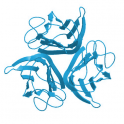
- Remove this product from my favorite's list.
- Add this product to my list of favorites.
Products
Newsletter
 |  |  |  |  |  |

Background
Ephrin type-B receptor 4(EPHB4) is also known as HTK, MYK1 and TYRO11,is a member of Eph family. The Eph family of receptors are divided into 2 groups based on the similarity of their extracellular domain sequences and their affinities for binding ephrin-A and ephrin-B ligands. Ephrin receptors make up the largest subgroup of the receptor tyrosine kinase (RTK) family. The protein encoded by EPHB4 binds to Ephrin-B2 and plays an essential role in vascular development. EPHB4 and its ligand ephrin-B2 are specifically expressed on venous and arterial endothelial cells, respectively, and play an essential role in vascular development via bidirectional signals. The forward EPHB4 signaling inhibits cell adhesion, chemotaxis, angiogenesis and tumor growth. Incontrast, the reverse Ephrin-B2 signaling exerts the opposite effect. It has been reported that aberrant expression of EPHB4 is associated with prostate cancer and highly malignant breast cancers, accordingly, EPHB4 has potential application as a therapeutic candidate.
Source
Recombinant MABSol® Biotinylated Human EphB4, His Tag, primary amine labeling (EP4-H8229) is expressed from human HEK293 cells. It contains AA Leu 16 - Ala 539 (Accession # NP_004435.3). It is the biotinylated form of Human EphB4, His Tag (EP4-H5229).
Predicted N-terminus: Leu 16
Molecular Characterization
This protein carries a polyhistidine tag at the C-terminus.
The protein has a calculated MW of 57.9 kDa. The protein migrates as 62-75 kDa under reducing (R) condition (SDS-PAGE) due to glycosylation.
Biotinylation
The primary amines in the side chains of lysine residues and the N-terminus of the protein are conjugated with biotins using standard chemical labeling method. A standard biotin reagent (13.5 angstroms) is used in this product.
Passed as determined by the HABA assay / binding ELISA.
Endotoxin
Less than 1.0 EU per μg by the LAL method.
Purity
>97% as determined by SDS-PAGE.
Formulation
Lyophilized from 0.22 μm filtered solution in PBS, pH7.4. Normally trehalose is added as protectant before lyophilization.
Reconstitution
Please see Certificate of Analysis for specific instructions.
For best performance, we strongly recommend you to follow the reconstitution protocol provided in the CoA.
Storage
For long term storage, the product should be stored at lyophilized state at -20°C or lower.
Please avoid repeated freeze-thaw cycles.
This product is stable after storage at:
-20°C to -70°C for 12 months in lyophilized state;
-70°C for 3 months under sterile conditions after reconstitution.
(1) "ED-71 Improves Bone Mass in Ovariectomized Rats by Inhibiting Osteoclastogenesis Through EphrinB2-EphB4-RANKL/OPG Axis"
Wang, Kou, Rong et al
Drug Des Devel Ther (2024) 18, 1515-1528
(2) "Multiple receptor tyrosine kinases regulate dengue infection of hepatocytes"
Bourgeois, Wei, Ho et al
Front Cell Infect Microbiol (2024) 14, 1264525
(3) "Eph-ephrin signaling couples endothelial cell sorting and arterial specification"
Stewen, Kruse, Godoi-Filip et al
Nat Commun (2024) 15 (1), 2539
Showing 1-3 of 862 papers.
Follow us